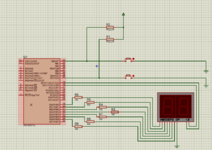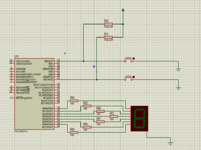IcyWolfBrain
Newbie level 4
Hello guys, i need help with MikroC Pro programming code and the task is following -
Using two 7-segment indicators and a PIC16F628A microcontroller, implement a number generator (range: 00 ÷ 99).
Initial state: 00. Control is realized by two buttons. If one button is pressed, the generator automatically performs increment generation (increment , +1),
if the other button is pressed, automatic decrementing of the number takes place.
In attached files is screenshoot of shematics PIC16F628A microcontroller connection structure, but i dont know it is connected right?
Please can someone tell if its right?
Can someone help me out with programming code?
Using two 7-segment indicators and a PIC16F628A microcontroller, implement a number generator (range: 00 ÷ 99).
Initial state: 00. Control is realized by two buttons. If one button is pressed, the generator automatically performs increment generation (increment , +1),
if the other button is pressed, automatic decrementing of the number takes place.
In attached files is screenshoot of shematics PIC16F628A microcontroller connection structure, but i dont know it is connected right?
Please can someone tell if its right?
Can someone help me out with programming code?


